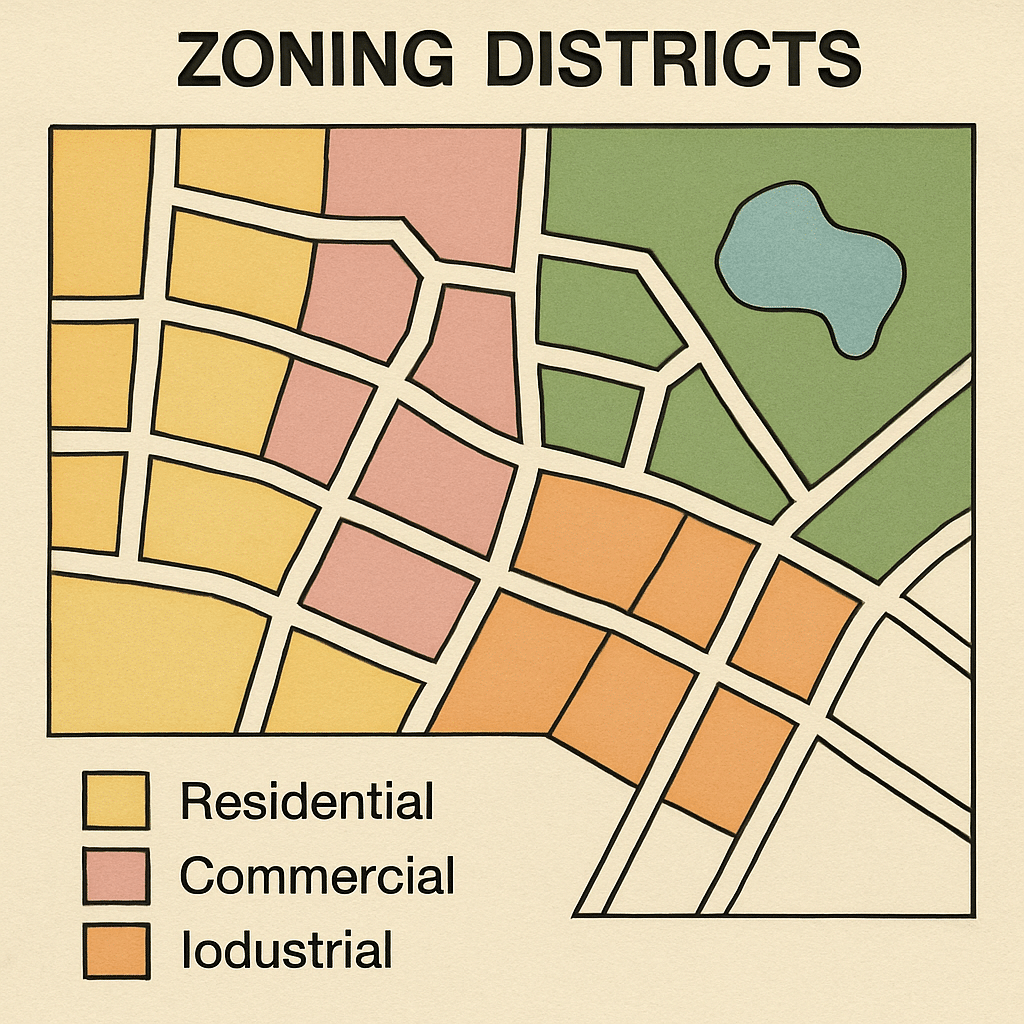Building on your own land might seem straightforward. However, it involves more than just breaking ground. A permit to build on your own land is essential.
Why is this permit necessary? It ensures your project complies with local building codes. These codes are in place to protect public safety and property values.
Without a permit, you risk facing serious consequences. These can include fines, legal action, or even demolition of your project.
The permit application process can be complex. It involves submitting detailed plans and paying fees. Understanding this process is crucial for a successful project.
Property zoning and permits also play a significant role. Zoning laws dictate what you can build and where. Ignoring these can lead to costly mistakes.
Building permits are not just bureaucratic hurdles. They are safeguards for quality and safety. They ensure your construction meets all legal requirements.
Whether you’re planning a new home or a renovation, permits are vital. They protect your investment and ensure compliance with regulations.
What Is a Building Permit and Why Is It Required?
A building permit is a government-issued document. It grants legal permission to start a construction project. This document is not merely a formality.
Building permits serve several crucial functions. They ensure that construction adheres to local building codes. These codes include safety standards designed to protect everyone.
Why are building codes so critical? They address health and safety aspects, ensuring structural integrity. Compliance prevents hazards like fire risks or structural collapses.
Issuing building permits also benefits the community. They help maintain property values and protect public welfare. Buildings that meet code requirements are safer and more reliable.
A building permit involves a review of project plans. Local authorities assess these plans to ensure code compliance. The aim is to confirm that the project won’t pose safety risks.
Here are key reasons why building permits are required:
- Ensure safety and health standards compliance
- Verify structural integrity
- Protect public welfare
- Maintain property values
Ignoring the need for a building permit carries risks. Undertaking construction without a permit can lead to severe consequences. Legal actions or fines are common results.
Understanding the importance of a building permit is crucial. It ensures safe and compliant construction on your land. This permission is vital for peace of mind and legal compliance.
Do I Need a Permit to Build on My Own Land?
Determining whether you need a permit often depends on local regulations. Not all projects require a permit, but many do. It’s essential to check with your local authorities before starting any construction.
Small-scale projects might not need a permit. Minor interior updates or landscaping usually don’t require one. However, significant changes almost certainly will.
Permits are commonly needed for structures that impact safety. Projects like building a new room or installing major plumbing often require permits. This is because they can alter your property’s integrity.
Here’s a quick checklist to help determine if you need a permit:
- Building a new structure
- Making structural changes to an existing building
- Extensive plumbing or electrical work
- Changing the use of a building
Failing to secure a permit can lead to costly complications. Your project may face fines, delays, or even demolition. Always verify permit requirements to avoid these risks.
Understanding the necessity of a building permit is a vital step. It ensures your construction meets legal standards and protects your investment. Consulting local building codes will clarify what your project requires.
Understanding Property Zoning and Permits
Property zoning impacts what and where you can build. Zoning laws divide land into districts, each with different rules. These laws help organize urban development and maintain community standards.
Zoning categories include residential, commercial, and industrial. Each has distinct regulations governing land use and construction. Knowing your property’s zoning classification is crucial before planning any construction.
Permits ensure compliance with these zoning laws. They are essential to confirm your project aligns with local ordinances. Without the right permits, you risk penalties or legal issues.
Typical zoning considerations include:
- Setback requirements
- Building height limitations
- Density allowances
- Usage restrictions

When seeking a permit, it’s essential to check zoning laws first. Some projects might need a variance if they don’t comply. A variance allows deviations from standard zoning rules, but it involves a detailed review process.
Understanding zoning laws and permits protects your investment and ensures community well-being. Taking the time to align with zoning requirements saves future headaches. Always consult local zoning maps and regulations when planning a build. Avoid unexpected roadblocks by doing diligent research upfront.
Types of Permits for Building on Land
Various permits may be necessary depending on your project’s nature. Understanding these permits is essential for legal compliance when building on land.
The most common type is the building permit. It’s essential for new structures, additions, or significant alterations. Homeowners often need this for both residential and commercial developments.
Another important permit is the land use permit. This is crucial when changing how a piece of land is used, such as converting a residential space to a commercial one. Land use permits ensure that the project aligns with zoning laws.
Additionally, a demolition permit might be needed. If your project involves tearing down existing structures, this permit is vital. It ensures that demolition is conducted safely and legally.
Here is a quick list of common permits:
- Building Permit
- Land Use Permit
- Electrical Permit
- Plumbing Permit
- Demolition Permit
Checking with your local government is always a good start. They can guide you through what you specifically need for your project. Failure to obtain required permits can cause delays or even result in fines. Always verify permit requirements early in the planning stage to avoid complications later.
The Permit Application Process: Step-by-Step
Navigating the permit application process can initially seem daunting. However, understanding each step can make it manageable and efficient.
First, research the specific permits required for your project. Your local building department can provide this information. Requirements vary significantly based on location and the project’s scope.
Next, prepare detailed plans and specifications. These documents must illustrate the design, materials, and methods you’ll use. Accuracy here is crucial to prevent delays.
After preparing your plans, submit them along with your application form. Most departments have online submission options to streamline this process.
Once submitted, your application undergoes a review process. Officials examine your plans to ensure they meet local building codes and regulations. This step might take several weeks, depending on the project’s complexity.
If your application is approved, you’ll receive your permit. This authorization allows you to begin construction legally. Keep this document on-site throughout your project.
Sometimes the application might be rejected. Common reasons include incomplete plans or non-compliance with zoning laws. If this happens, address the issues cited and resubmit.
Throughout construction, inspectors will visit to ensure compliance with approved plans. Passing these inspections is vital for final approval.
Here’s a quick list to guide your application preparation:
- Research required permits
- Prepare detailed plans
- Submit application with plans
- Await review and approval
Moreover, during the construction process:
- Expect site inspections
- Address any compliance issues
- Obtain final approvals
Being thorough in the application phase can save time and stress later. Keep a checklist to track each step. Staying organized helps ensure a smooth process, allowing you to focus on building your project safely and legally.
Building Code Compliance and Construction Regulations
Building code compliance is a critical aspect of any construction project. These codes are designed to ensure safety and quality standards.
Local governments develop building codes to protect public welfare. They cover a variety of aspects, such as structural integrity, fire safety, and accessibility. Complying with these codes is mandatory.
Construction regulations go hand in hand with building codes. They establish guidelines for construction practices. Regulations can include environmental considerations, historical preservation, and zoning laws. Ignorance of these rules can lead to serious consequences.
Failing to adhere to building codes or construction regulations can result in penalties. The risks include fines, court actions, and the removal of unauthorized structures. Additionally, non-compliance might complicate future property transactions, such as sales or refinancing.
Here is a summary of key points for building code compliance:
- Ensure structural integrity
- Focus on fire safety measures
- Meet accessibility requirements
- Consider environmental impact
- Respect historical sites
Understanding these requirements and adhering to them is essential for any construction project. Not only do they ensure safety and legality, but they also safeguard property values. It’s wise to consult with professionals to navigate these complexities effectively. This proactive approach helps prevent costly mistakes and ensures a smooth building process.
Home Renovation Permits vs. New Construction Permits
Home renovation permits and new construction permits serve different purposes. While both are crucial for compliance, their requirements vary.
Renovation permits are typically needed for modifications to existing structures. This includes extensive remodeling, additions, or changes to major systems like electrical and plumbing. These permits ensure that any updates are safe and adhere to current standards.
New construction permits apply to building projects from the ground up. They encompass a wide range of regulations, from excavation to final inspections. Due to their complexity, new construction permits often involve thorough reviews by local authorities.
Here are key differences between home renovation permits and new construction permits:
- Renovation Permits: For existing structures, focus on system updates.
- New Construction Permits: For building from scratch, extensive regulations apply.
- Scope: Renovation permits may have simpler processes; new construction involves comprehensive reviews.
Understanding the specific permit type you need can streamline the permit process. It’s essential to verify requirements with local authorities before commencing any project.
Cost of a Building Permit: What to Expect
The cost of a building permit can vary widely. It depends on factors such as location, project scope, and type of construction. Local government policies also play a role in determining fees.
Typically, permit costs are calculated as a percentage of the total construction budget. This means larger projects often have higher permit fees. Additional factors, like complex zoning requirements, can further affect the overall cost.
Here are some key considerations impacting permit costs:
- Project Size: Larger projects usually incur higher fees.
- Location: Permit costs differ based on local jurisdiction.
- Complexity: Detailed projects might require specialized permits, increasing costs.
It’s important to budget for these expenses early in your planning process. Failing to account for permit fees can lead to unexpected financial strains. Always check with local authorities for the most accurate pricing and requirements.
Legal Requirements for Building a House on Private Property
Building a house on private property involves adhering to several legal requirements. These regulations ensure your construction is safe and compliant with local laws. Ignoring these requirements can lead to serious consequences.
First, you must secure the necessary permits. This includes a building permit, which is crucial for any new construction. Depending on the project, additional permits may be required.
Property zoning laws are another critical aspect. Zoning determines the type of structures that can be erected on the land. It ensures that residential, commercial, and other areas are properly managed.
Here is a list of key legal considerations when building on private property:
- Building Permit: Essential for legal construction.
- Zoning Compliance: Adhere to local zoning laws.
- Environmental Regulations: Consider environmental impact.
- Utility Connections: Ensure proper hookups for water, electric, etc.
Ensuring all legal requirements are met is vital for a smooth construction process. Always consult with local authorities to understand specific legal obligations in your area. Being proactive in this process helps prevent future legal issues and project delays.
Building Without a Permit: Consequences and Risks
Building without a permit can lead to significant risks and consequences. It may seem like a shortcut, but it often causes more trouble than it’s worth.
Legal penalties are one of the most immediate risks. Authorities can impose fines or require you to halt construction until you obtain the necessary permits.
In some cases, you might be forced to demolish the structure. This can happen if the building does not comply with building codes or zoning laws.
Here are potential legal consequences for building without a permit:
- Fines and Fees: Financial penalties are often imposed.
- Legal Action: You could face lawsuits or court orders.
- Demolition Orders: Non-compliant structures may need to be torn down.
Additionally, building without a permit can complicate future property transactions. Potential buyers or lenders may have concerns about illegal construction, impacting your property’s marketability.
Insurance issues can also arise. Without a permit, your insurance company might refuse coverage for any damages or liabilities related to the unapproved construction.
Here’s how it can affect your property:
- Resale Complications: Difficulty in selling or refinancing.
- Insurance Denials: Limited or voided insurance coverage.
- Safety Risks: The structure might not meet safety standards.
One should always consider the long-term effects of building without a permit. While it might offer short-term savings, the potential costs and complications can be far more burdensome.
Building legally with the proper permits not only avoids these consequences but also ensures that your project is safe and up to code. Always prioritize obtaining the necessary permits before starting any construction project.
Inspections and Final Approvals
After obtaining the necessary permits, the construction phase begins, but inspections play a crucial role in the process. Inspectors ensure that your construction complies with approved plans and local codes, maintaining safety and quality standards.
Each major phase of your project may require inspection. This could include the foundation, electrical systems, plumbing, and final structure. Missing an inspection can delay your project and lead to costly revisions.
Here are some typical inspections during construction:
- Foundation Inspection: Ensures structural safety.
- Framing Inspection: Confirms proper installation.
- Final Inspection: Verifies everything meets code.
The final approval is your last hurdle before project completion. Once inspectors verify compliance, they will issue a certificate of occupancy or a similar document. This final approval assures you and future buyers that your building is safe and complies with all necessary regulations. Getting this approval is essential for insurance and future property sales. Proper inspections and approvals protect your investment.
Common Mistakes and How to Avoid Them
Building projects are complex, and even small mistakes in the permit process can lead to big problems. One frequent error is not checking local regulations thoroughly. Overlooking this can result in a project that violates zoning laws.
Failing to submit complete and accurate plans is another common mistake. Missing or incorrect details can cause delays in the permit application process. Ensuring your plans are comprehensive and precise will help streamline approvals.
Here’s a list of common mistakes and tips to avoid them:
- Skipping Research: Always verify zoning laws and local rules before starting.
- Incomplete Applications: Double-check your application for missing information.
- No Professional Help: Consider hiring an expert for guidance.
Avoiding these pitfalls is crucial for a smooth project. Proper planning, attention to detail, and asking for professional help when needed can prevent setbacks and ensure a successful build.
Frequently Asked Questions About Building Permits
Navigating the building permit landscape can be daunting. Many property owners have similar questions. Here’s a look at some common inquiries.
What is the first step in obtaining a permit? The initial step is to contact your local building department. They can provide specific guidelines relevant to your area.
How long does the permit process typically take? The duration varies depending on the complexity of the project. Simple projects might be approved in a few weeks, while complex projects can take months.
Many wonder about the cost of a permit. Fees are usually based on the project’s scope and location. Always check with local authorities for precise figures.
Will I need multiple permits for one project? Often, yes. You may need separate permits for electrical, plumbing, and structural work.
Common questions often include:
- Is a permit necessary for minor renovations? Sometimes, but not always. Verify with local authorities.
- Do permits expire? Yes, and renewal policies differ by location.
Understanding these FAQs can ease the permit process. Clarifying the permit requirements before starting can help you avoid unnecessary delays and compliance issues. Always reach out to your local permit office with any doubts or additional questions.
Tips for a Smooth Permit Process
Successfully obtaining a permit can seem challenging, yet preparation is key. Start by researching local regulations. Understanding these rules helps prevent costly mistakes.
Efficient documentation is crucial. Ensure that your plans and paperwork are thorough. Double-check every detail before submitting your application. This step can prevent unnecessary back-and-forth with the permit office.
Communication with officials can also ease the process. Be proactive in seeking clarity on ambiguous requirements. Consider these tips:
- Engage a professional: Architects or builders often know permit nuances.
- Allow for buffer time: Delays happen, so plan extra time.
- Stay informed: Track changes in local building codes.
These strategies will support a smoother process. Remember, patience and diligence pave the way for successful permit acquisition. Consistent follow-through reduces surprises and facilitates a more predictable outcome.
Conclusion: The Importance of Permits for Safe and Legal Building
Building permits are more than just paperwork; they protect you and your community. They ensure that construction adheres to safety and quality standards. This adherence prevents hazards and supports neighborhood harmony.
The legal requirements for building create a framework for responsible development. Without permits, you risk legal troubles and financial setbacks. Ensuring compliance saves you from future complications.
Respecting these regulations fosters trust with local authorities and your neighbors. It demonstrates a commitment to abiding by community standards. By obtaining the necessary permits, you contribute to safer and more sustainable construction practices. In turn, this protects property values and benefits everyone involved.




